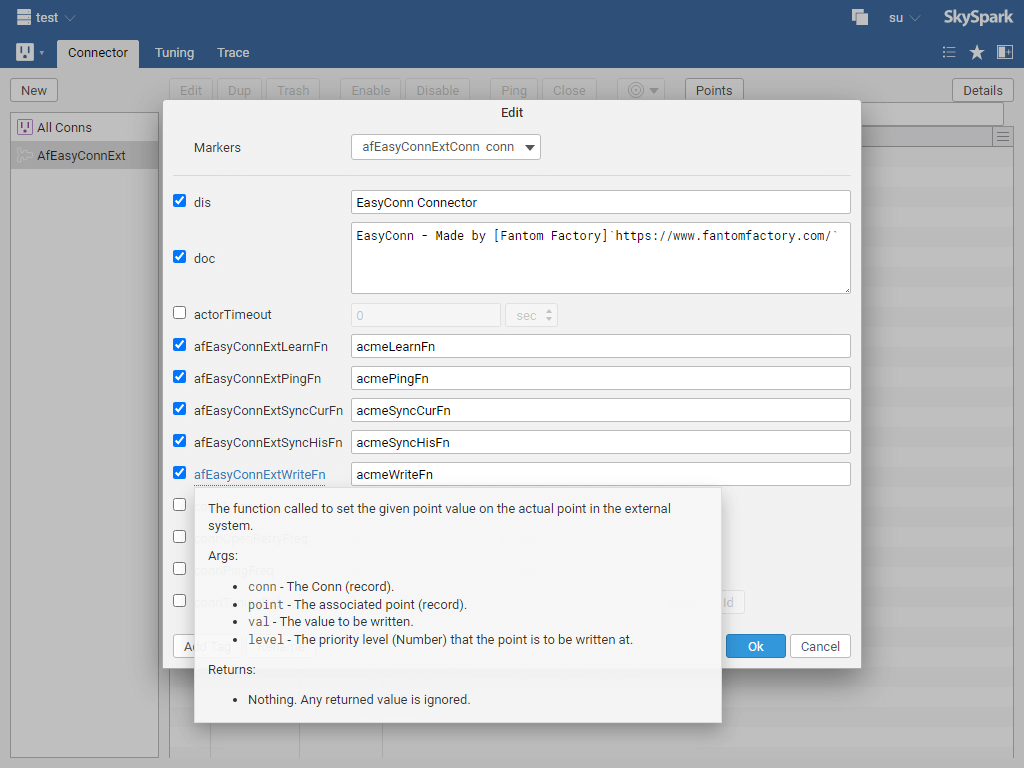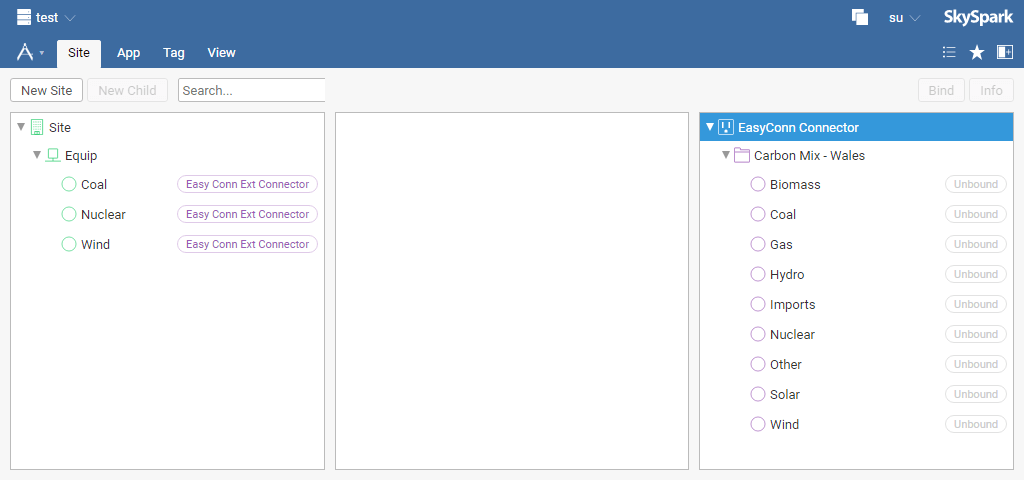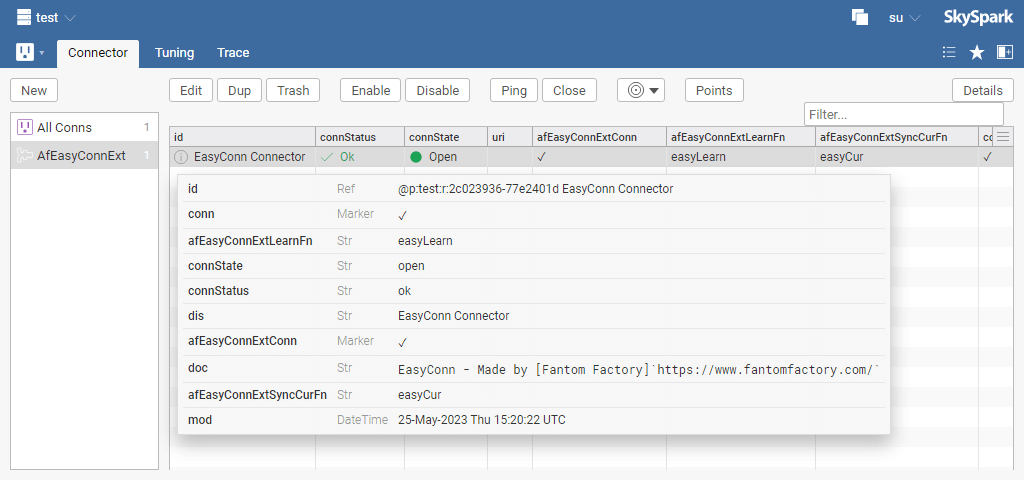Registered StackHub users may elect to receive email notifications whenever a new package version is released or a comment is posted on the forum.
There are 0 watchers.
EasyConn provides a framework for creating your own SkySpark Connectors from Axon functions.
The EasyConn extension provides Axon support for:
This connector has been developed for SkySpark v3.1.6 or later.
EasyConn is FREE to download and evaluate for up to 100 Axon calls. Watch our video tutorial to understand how easy we make it to create and use your own connector - with Axon.
Fortified with Fantom! Robust, secure, and optimised, the EasyConn extension helps you to do more "in-house" with less reliance on bespoke Fantom knowledge!
EasyConn works great with Fantom Factory's HTTP Client for making calls to REST APIs.
Sufficient Axon knowledge will be needed to use this software extension.

EasyConn connectors work by delegating standard SkySpark connector functionality, such as obtaining curVals for points, to custom Axon functions that YOU write.
ping, learn, syncCur, syncHis, and write.
To operate, EasyConn just needs the names of a few Axon functions to be tagged on the connector record.
Each Axon function is optional, depending on which features the connector is to implement.
Each Axon function written and supplied to the EasyConn connector must define a specific argument signature and return data as intended. These functions are described in the sections below, complete with dummy examples.
Real working Axon code for these functions can be found the Real example and Advanced example sections.
Note that all Axon functions are executed under a synthesised User with Admin permissions.
This function is called in response to a connector ping.
Functions should make a request to the end server, to ensure that authentication works and the endpoints are accessible.
If possible, the ping function should return a Dict of server information. The tags in the Dict get stored on the connector record, to aid in debugging. Even storing a lastPingTs can be helpful to see when the last successful connection was!
Args:
conn - The Conn (record) being pinged.Returns:
// Example Ping func(conn) => do// ensure we have connectivity to the API end pointres : `https://api.foobar.com/ping`.ioReadTrio// return tags for the Connreturn { lastPingTs : now(), fooVer : res.first->version, } end
The "Learn" function as used in the SkySpark Builder Application and is responsible for:
Args:
conn - The Conn (record).arg - a Str that identifies the parent node in the tree (if any).Returns:
The "Learn" function is called for every non-leaf node in the Learn tree.
The first time it is called, arg is null to designate the top-level tree object. It is then called very time a node in the Learn tree is expanded (when the arrow icon is clicked).
It is the expectation that the Learn function will call out to a REST API to obtain a list of points (and associated metadata) that can be bound in SkySpark.
To create a point that can be bound in SkySpark, return a Grid row with the following tags.
dis - The display name (Str) to be shown in the tree.kind - A Str of either Bool, Number, or Str to designate the kind of point value. Number points should also return a unit tag.his / cur / writable - At least one of these three tags are required to bind the point, each designates what the point is able to do.
his allows the point to collect and sync historycur allows the point to be polled for a curValwritable allows the point to be written to... - All other (custom) tags returned will also set on the point record.If a point contains the cur tag, there must also be a Sync Cur function to retrieve the point's curVal.
If a point contains the his tag, there should also be a Sync His function to retrieve the point's historical data.
If a point contains the writable tag, there should also be a Writable function to set a value on the actual point.
Because these other functions need to identify individual points and how they relate to data found in REST APIs, it is important that other custom identifying tags are also set on points.
Because an external system / REST API may return hundreds of points to display in the Learn tree, it is possible to categorise and group them under expandable tree nodes.
To create an expandable node, return a row with the following tags.
dis - The display name (Str) to be shown in the tree.learn - The arg argument (Str) passed to be passed when the node is expanded.... - Other tags may be returned for informational purposes.// Example Learn func(conn, arg : null) => do// at the top level, return expandable nodesif (arg == null) return [ { learn: "/node1", dis: "Node 1" }, { learn: "/node2", dis: "Node 2" }, ].toGrid()// return points under node 1if (arg == "/node1") return [{ "dis" : "My first point", "kind" : "Number", cur,// set custom identifying tags"myId" : "pointId_onServer", }].toGrid()// return points under node 2if (arg == "/node2") do ... end end
This function is called when points are polled to update their curVals. It should retrieve the curVal for each point in the given List.
Args:
conn - The Conn (record).points - A List of point records that require new curVals.Returns:
pointRef) and a column of new current values (val).It is expected that the function communicates with an external system / REST API to obtain the curVals.
To help identify the point on the external system, the point record will contain all the tags returned by the Learn function when the point was bound.
// Example Sync Cur func(conn, points) => do curVals : points.map() (point) => do ...// get the curVal for each pointcurUrl : "https://api.foobar.com/curVal/" + point->myId curVal : curUrl.parseUri.ioReadStr.parseNumber ... return { pointRef: point->id, val: curVal } end// return a grid of curValsreturn curVals.toGrid end
By adding the cur tag to a point, the point is automatically polled for a curVal whenever it is watched. Points are watched when it has a hisCollectInterval tag or when the point is viewed in the Monitor App or the Connector App.
EasyConn uses the buckets polling mode so, to change the default polling frequency of 10 seconds, set the pollTime tag on a connector tuning record.
This function is called to return time-series history for a given his point.
Args:
conn - The Conn (record).point - The his point (record) to be synced.span - The Span of time requested to by synced.Returns:
ts column of DateTims and a val column of point values.It is expected that the function communicates with an external system / REST API to obtain the time-series data.
To help identify the point on the external system, the point record will contain all the tags returned by the Learn function when the point was bound.
// Example Sync His Func(conn, point, span) => do// get the history datahisUrl : "https://api.foobar.com/history/" + point->myId + "/" + span hisVal : hisUrl.parseUri.ioReadJson hisList : hisVal.map() (row) => do return { ts:row->ts, val:row->val } end return hisList.toGrid() end
This function should set the given point value on the actual point in the external system.
Args:
conn - The Conn (record).point - The associated point (record).val - The value to be written.level - The priority level (Number) that the point is to be written at.Returns:
It is expected that the function communicates with an external system / REST API to set the point value.
The level argument is only applicable should the external system utilise a BACnet 16-level priority array (or similar!).
// Example Write Func(conn, point, val, level) => do// write the value to the endpointwriteUrl : "https://api.foobar.com/write/" + point->myId + "/" + val writeUrl.parseUri.ioReadStr end
If you are looking to sync data with HTTP REST APIs, then let Fantom Factory's HTTP Client help!
HTTP Client is an extension for SkySpark that provides powerful Axon functions for making HTTP requests and calling REST APIs.
HTTP Client boasts the following features:
GET, POST, PUT, DELETE, OPTIONS, etc...BASIC, BEARER, DIGEST, Project Haystack / SkySpark SCRAM, header, path, and query authentication mechanismsgzip and deflate response de-compressionThe standard suite of IO functions in SkySpark makes basic HTTP GET requests. But to make HTTP POST requests or to set HTTP authentication headers, another SkySpark library / extension is required.
Fantom Factory's HTTP Client is the only extension available that allows credentions to be saved in SkySpark's secure storage and then used securely in HTTP requests.
Once you have a connector developed with Easy Conn it will need to go live on a production SkySpark (because it was developed on a separate development / testing instance SkySpark, right!?).
To do that, the EasyConn extension will need to installed on the production SkySpark, and the custom Axon functions (that you wrote) will need to be copied over.
Note that a separate EasyConn licence will need to be purchased for the production SkySpark server.
There are many ways to copy Axon funcs from SkySpark to SkySpark, but a great and easy way is to bundle the functions up into a .pod file, and just copy / install the single .pod file over. For this, there is no easier way than to use Fantom Factory's Pod Builder.
Pod Builder compiles Axon functions, Haystack Defs, and other Folio records, into valid SkySpark extensions. That, combined with its StackHub integration, provides a simple and convenient way to distribute your amazing EasyConn connectors!
If distributing Axon connector functions to client SkySpark servers, you may not want to give the client access to your Axon source code. If so, then Fantom Factory's Axon Encryptor is the tool for you! Axon Encryptor obfuscates and protects your Intellectual Property with source code encryption for Axon!
Following below are sample Axon functions for EasyConn Learn and Sync Cur functionality.
These sample funcs may be used to create a simple connector that connects to the HTTP REST API provided by the UK's NationalGrid to obtain mixed carbon intensity values for the electrical power generation of the country of Wales (UK).

Note that the carbon intensity data is only updated every 30 minutes - so the connector can be tuned down appropriately.
This specific example, connecting to the UK's National Grid, was chosen because the data is publicly available and the REST API does NOT require any form of authentication.
To setup, create the functions easyLearn and easyCur as show below, then add the following tags to your EasyCon connector record.
afEasyConnExtLearnFn : "easyLearn" afEasyConnExtSyncCurFn : "easyCur"

Also see the Advanced Example for a larger / more complete example of EasyConn Axon functions.
// func// name : easyLearn// doc : Sample Learn Func(connRef, arg : null) => do// let the top-level be a single expandable nodeif (arg == null) return [{ dis : "Carbon Mix - Wales", learn : "/wales" }].toGrid()// contact the api to return and extract point dataurl : `https://api.carbonintensity.org.uk/regional/wales` json : ioReadJson(url, {safeNames}) dataDict : json["data"][0] regionDict : json["data"][0]["data"][0]// map the json data to pointslearnItems : regionDict->generationmix.map() (dict) => do return { "dis" : dict->fuel.capitalize, "kind" : "Number", "unit" : "%", "ciType" : "generation", "ciKey" : dict->fuel, cur, } end return learnItems.toGrid end
// func// name : easyCur// doc : Sample Sync Cur Func(conn, points) => do url : `https://api.carbonintensity.org.uk/regional/regionid/17` json : ioReadJson(url, {safeNames}) mixes : json["data"][0]["data"][0]["generationmix"] curVals : points.map() (point) => do data : mixes.find() (mix) => mix["fuel"] == point["ciKey"] return { pointRef : point->id, val : data["perc"] } end return curVals.toGrid() end
EasyConn exists to enable Axon programmers to develop their own connectors for SkySpark.
While EasyConn will be sufficient for many use-cases, and an excellent get out of jail free card, a heavy reliance on EasyConn for frequent polling, or a large number of points, or for high-traffic situations - may result in poor performance and system degradation.
For these situations, consider investing in or commissioning a native connector written in pure Fantom. Fantom is the native language of SkySpark and lends itself towards creating optimised code extensions.
Fantom Factory is experienced at writing optimised connectors that leverage:
Contact Fantom Factory for details.
To make the most out of your EasyConn connector - here are some optimisation tips.
Try to reduce the number of HTTP / API calls. This can be particularly important when retrieving curVals.
A 1000 points polling every 10 seconds (the SkySpark default) could mean the connector is making 6000 HTTP calls every minute!
Should your REST API supply the means to, try to make use of endpoints that return multiple curVals for a single HTTP call.
By default SkySpark polls connectors to update the curVals on their points every 10 seconds. This can be a lot for an Axon connector, so consider adding a standard tuning record with an decreased polling frequency.
Use the pollTime tag on the connector's tuning record - see SkySpark Conn Tuning for details.
A polling frequency of half the hisCollectInterval will ensure no loss of collected data fidelity.
Session authentication tokens, like BEARER tokens used in OAUTH2, could be cached as transient tags (say, on the connector record) to prevent re-authentication before every HTTP call - thus halving the number of HTTP calls made.
Further documentation on Points and Connectors as implemented in SkySpark.
EasyConn is a commercial product and requires a licence to be purchased to run in production.
Licences for EasyConn are tied to a SkySpark installation / host ID. This means to use EasyConn on multiple SkySpark installations will require multiple licences; one per installation. Be sure enter your SkySpark licence ID when purchasing, see Where is my SkyArc Installation ID? for details.
Purchased licences are available from the My Licences page on StackHub and should be downloaded to the /var/lic/ directory of your SkySpark installation.
Minor updates to EasyConn may be provided free of charge, but major updates will require a new licence to be purchased.
The End-User License Agreement ("EULA") is contained with the downloaded .pod file.
For support and comments, please email -------------------------.
If EasyConn does not find a valid licence, it enters into an evaluation mode whereby a maximum of 100 Axon calls may be made; after which EasyConn will throw a licence fault.
Evaluation mode is designed for developers to try out various features of EasyConn to assess its suitability for purpose.
The software is provided "AS IS" and the author disclaims all warranties with regard to this software including all implied warranties of merchantability and fitness. In no event shall the author be liable for any special, direct, indirect, or consequential damages or any damages whatsoever resulting from loss of use, data or profits, whether in an action of contract, negligence or other tortious action, arising out of or in connection with the use or performance of this software.
Special thanks go to Healthy Workers for sponsoring, supporting, and beta testing the EasyConn SkySpark connection.
| Version | 1.0.0 |
|---|---|
| License | Commercial |
| Build date | 2 years ago on 26th May 2023 |
| Requirements | SkySpark v3.1.6 |
| Depends on | |
| File name | afEasyConnExt.pod |
| File size | 157.51 kB |
| MD5 | 36f87e2ed50b45dc730d85941b3a8168 |
| SHA1 | 5e5cd9c2041abca27e4bf84e3b67a393e424eff9 |
Published by Fantom FactoryDownload nowAlso available via SkyArc Install Manager | |